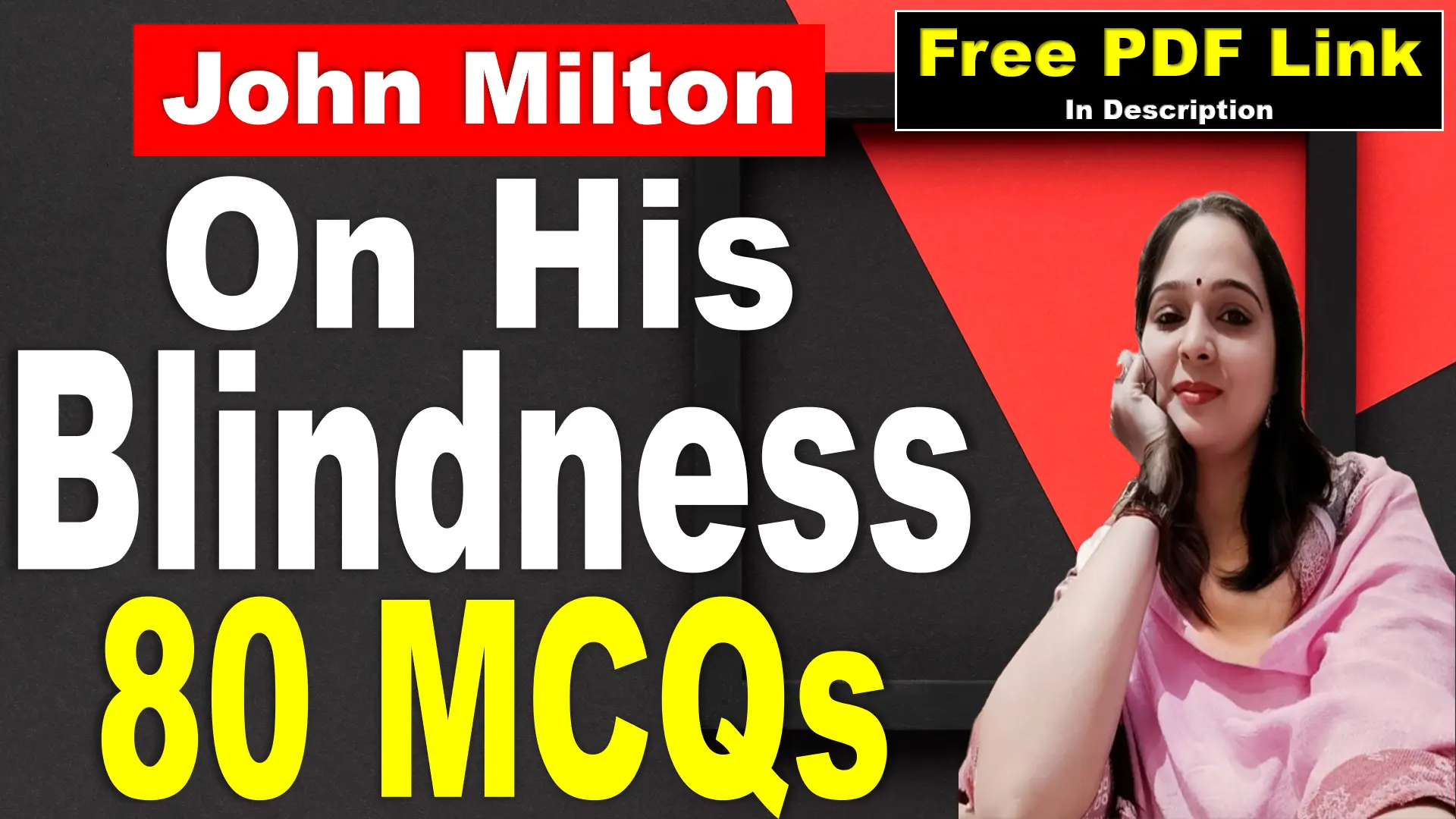
Write the critical appreciation of the poem “To the Skylark by William Wordsworth”.
Introduction
“To the Skylark” is a poem written by William Wordsworth, a key figure in the Romantic movement. The poem expresses Wordsworth’s deep love for nature and his philosophical thoughts on life. Through the skylark, a bird known for its beautiful song, Wordsworth explores ideas about reaching for spiritual heights while staying connected to the simple, everyday aspects of life.
Central Idea
The poem’s main idea is about finding a balance between aiming high in life and staying grounded. The skylark symbolizes this balance as it flies high in the sky but remains connected to its nest on the ground. Wordsworth admires the bird for its ability to be both ambitious and practical, seeing it as a model of wisdom.
Structure & Rhyme Scheme
The poem is made up of 3 stanzas, each following a regular ABABCC rhyme scheme. This pattern gives the poem a smooth, flowing rhythm that matches the skylark’s graceful flight and its harmonious song. The consistent rhyme scheme also adds to the poem’s musical quality, reflecting the beauty of the skylark’s song.
Theme
The poem touches on several important themes. One key theme is the balance between ambition and being grounded. The skylark represents how one can reach for spiritual and intellectual heights while still being connected to reality. Another theme is the connection between nature and spirituality, with the skylark symbolizing the divine wisdom found in nature. The poem also explores the idea that true wisdom involves balancing one’s dreams with a practical approach to life.
Style
Wordsworth’s style in the poem is simple yet profound, typical of Romantic poetry. He uses vivid imagery and emotional language to convey his admiration for the skylark and its symbolic meaning. The direct address to the skylark makes the poem feel personal and intimate, as if the bird is a close companion. The overall style is reflective, encouraging readers to think deeply about the themes presented.
Poetic Devices
Wordsworth uses several poetic devices to enrich the poem. Apostrophe is used when the speaker directly talks to the skylark. Metaphors like “ethereal minstrel” and “pilgrim of the sky” give the skylark a spiritual significance. Imagery paints clear pictures of the bird’s surroundings and its song. Personification gives the skylark human-like qualities, making it a symbol of wisdom. Alliteration and enjambment help create a smooth rhythm, enhancing the poem’s flow and musicality.
Critical Commentary
Harold Bloom: Literary critic Harold Bloom has remarked on the depth of Wordsworth’s connection with nature in “To the Skylark,” noting that the poem is emblematic of Wordsworth’s belief in nature as a source of spiritual insight. Bloom emphasizes how the skylark, in Wordsworth’s hands, becomes more than just a bird; it is a symbol of the poet’s aspiration to transcend earthly concerns while remaining grounded in reality.
M. H. Abrams: Renowned literary scholar M. H. Abrams has commented on the use of contrast in the poem, particularly between the skylark and the nightingale. He points out that Wordsworth uses these two birds to explore different forms of poetic inspiration—one that is private and introspective, and another that is open and expansive. Abrams sees the skylark as embodying Wordsworth’s ideal of poetry that connects the personal with the universal.
Jonathan Bate: Environmental critic Jonathan Bate highlights the ecological dimensions of “To the Skylark,” suggesting that Wordsworth’s portrayal of the skylark reflects his broader environmental ethics. Bate argues that the poem shows Wordsworth’s respect for the natural world, where the skylark’s song represents a harmony that humans should strive to achieve in their own lives. He sees the skylark as a reminder of the interconnectedness of all life.
Geoffrey Hartman: Geoffrey Hartman, a scholar of Romantic literature, has explored the spiritual symbolism in “To the Skylark.” Hartman notes that Wordsworth often uses birds as symbols of spiritual freedom and transcendence, and the skylark in this poem is no exception. He sees the skylark as a representation of the soul’s ability to rise above earthly troubles and connect with the divine, embodying the Romantic ideal of the sublime.
Mary Jacobus: Feminist critic Mary Jacobus has analyzed the role of gender in Romantic poetry, including “To the Skylark.” Jacobus suggests that Wordsworth’s use of the skylark can be read as a commentary on the male Romantic poet’s aspiration to achieve a balance between creativity and domesticity. She argues that the skylark’s connection to both the sky and the nest mirrors the poet’s struggle to reconcile public ambition with private responsibilities.
Christopher Ricks: Christopher Ricks, a well-known critic, has praised the poem for its musical qualities, noting how Wordsworth’s use of rhythm and rhyme creates a sense of harmony that mirrors the skylark’s song. Ricks appreciates the way Wordsworth’s language in the poem reflects the bird’s graceful flight, creating a lyrical effect that enhances the reader’s experience of the poem.
Northrop Frye: Literary theorist Northrop Frye has commented on the symbolic significance of the skylark in the context of Wordsworth’s broader oeuvre. Frye argues that the skylark in this poem represents an idealized vision of poetic creation, where the poet aspires to reach new heights of understanding while remaining connected to the common experiences of life. Frye sees the skylark as a symbol of the poetic imagination’s ability to bridge the gap between the ordinary and the sublime.
Message
The poem’s message is about finding balance in life. Wordsworth suggests that, like the skylark, people should aim high but also stay connected to their roots and responsibilities. The skylark shows that it’s possible to be both ambitious and grounded, which is the essence of true wisdom. The poem encourages us to learn from nature, which can teach us valuable lessons about living a balanced and fulfilling life.
Conclusion
“To the Skylark” is a beautifully written poem that showcases William Wordsworth’s talent for combining simple language with deep meaning. Through the skylark, he explores important ideas about life, wisdom, and the connection between the natural world and the divine. The poem’s structure, style, and poetic devices all work together to create a piece that is both thought-provoking and enjoyable to read. Wordsworth’s message about the importance of balance continues to resonate, making this poem a timeless classic.
Long note on themes used in the poem “To the Skylark”
William Wordsworth’s poem “To the Skylark” explores several important themes that reflect his ideas as a Romantic poet. These themes include finding a balance between reaching for high goals and staying grounded, understanding the connection between nature and spirituality, appreciating wisdom, and contrasting different ways of living and creating art. Each theme is woven into the poem, giving it deeper meaning and making it resonate with readers.
1. Aspiration and Groundedness
One of the key themes in the poem is the balance between having big dreams and staying grounded. The skylark, the bird featured in the poem, symbolizes this balance. The bird flies high into the sky, representing the human desire to achieve great things spiritually and intellectually. However, even as it soars, the skylark remains connected to its nest on the ground, showing the importance of staying rooted in reality and holding onto one’s values and responsibilities.
Wordsworth believes that true wisdom is found in being able to aspire to great heights without losing sight of what is important in life. The skylark’s ability to return to its nest whenever it wants symbolizes that one can achieve high goals while still staying grounded, which Wordsworth sees as essential for living a happy and balanced life.
2. Nature and Spirituality
As a Romantic poet, Wordsworth was very interested in the connection between nature and spirituality. In “To the Skylark,” he explores this theme by portraying the skylark as a divine creature, an “ethereal minstrel” whose song brings harmony to the world. The skylark’s flight and song are seen as spiritual acts that connect the earth to the heavens, suggesting that nature itself is a source of spiritual wisdom.
The skylark’s existence in “glorious light” is contrasted with the nightingale, which is associated with the “shady wood.” This difference highlights the idea that nature, when open and pure, can inspire us with divine insights. Wordsworth seems to suggest that by observing and connecting with nature, people can discover deeper spiritual truths.
3. Wisdom
Wisdom is a central theme in the poem, especially in how the skylark is described as a “Type of the wise who soar, but never roam.” This line captures Wordsworth’s view that wisdom involves striving for higher ideals while maintaining a sense of purpose and direction. The skylark, with its connection to both the sky and the ground, symbolizes the ideal way of living—where one can aim for spiritual and intellectual greatness without losing touch with reality.
Wordsworth contrasts this idea of wisdom with roaming, which suggests wandering aimlessly. The skylark’s wisdom lies in its ability to navigate between the spiritual and the earthly, making it a model for human behavior. This theme closely relates to the idea of balance, showing that wisdom is found in harmonizing different parts of life.
4. The Contrast Between Different Approaches to Life and Art
The poem also explores the contrast between different approaches to life and art, using the skylark and the nightingale as symbols. The nightingale, traditionally celebrated in poetry for its beautiful song, is linked to introspection, darkness, and solitude. It sings from the shadows of a “shady wood,” representing a more private, inward-looking form of beauty and wisdom.
In contrast, the skylark represents a more open and outward approach, singing in the bright, open sky and sharing its song with the world. This contrast can be seen as a reflection on different ways of living and creating art—one that is secluded and introspective, and one that is open and expressive. Wordsworth seems to value the skylark’s approach more, as it represents qualities of openness, sharing, and a connection to the divine.
5. The Power of Harmony and Music
Another theme in the poem is the power of harmony and music. The skylark’s song is described as a “flood of harmony” that spreads across the world, suggesting that music and harmony have the power to uplift and transform. This theme aligns with the Romantic idea that music and poetry express deep emotional and spiritual truths.
In the poem, the skylark’s music is more than just a beautiful sound; it symbolizes the harmony that can be achieved when one balances aspiration with being grounded, spirituality with reality, and the earthly with the divine. This theme emphasizes that true beauty and wisdom are found in harmony, whether in nature, music, or life itself.
Conclusion
“To the Skylark” is a poem filled with themes that are central to Wordsworth’s Romantic philosophy. Through the skylark, Wordsworth explores the balance between reaching for high goals and staying grounded, the relationship between nature and spirituality, the nature of wisdom, and the contrast between different approaches to life and art. The skylark, with its ability to soar high while remaining connected to its nest, represents the harmonious blending of these themes, offering a model for living a wise and fulfilling life. Wordsworth’s reflections on these themes encourage readers to think about their own lives and how they balance their ambitions with their connections to the world around them.





